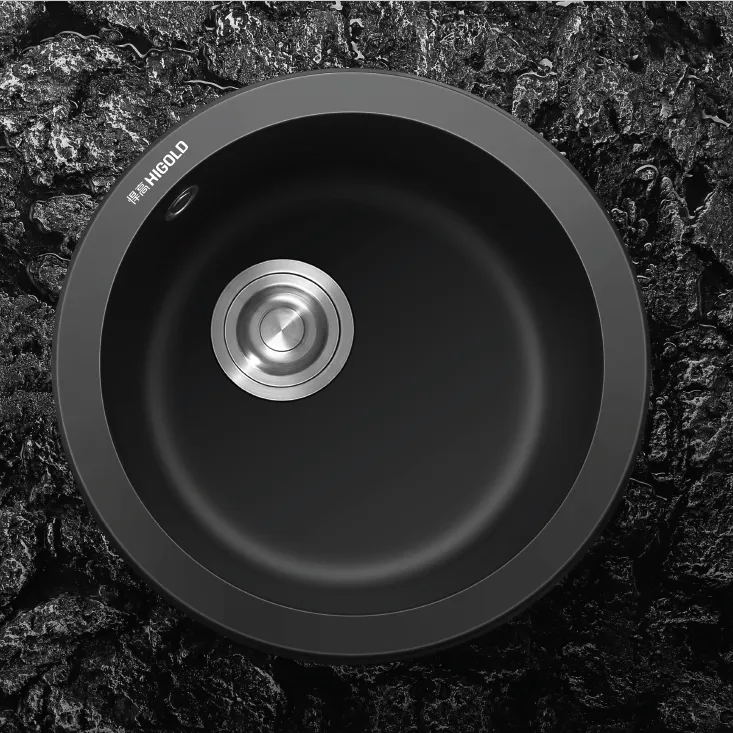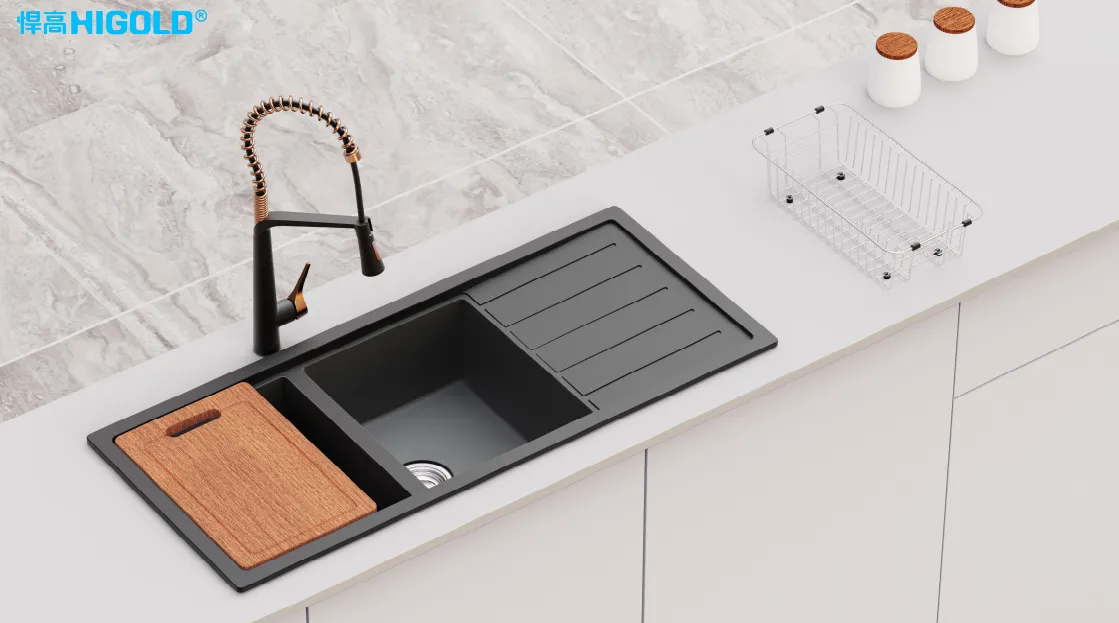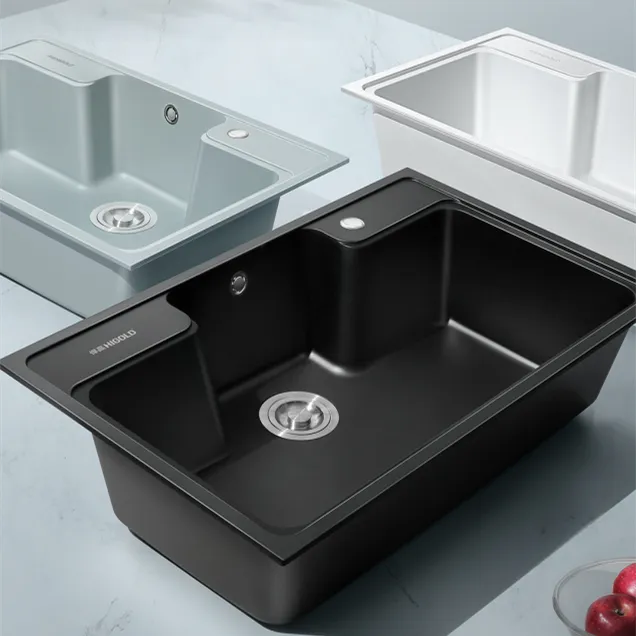With the increasing emphasis on aesthetics and practicality in modern kitchen design, black quartz sinks have become a popular choice for many families. Their deep color, high-end texture, and durable characteristics have contributed to their rapid rise in popularity.
However, in actual use, many consumers have found that black quartz sinks tend to turn white, dull, or even exhibit uneven coloring after a period of use. How to keep a black quartz sink looking its best has become a major concern for many families.
This article will address this issue, providing a detailed analysis of the material properties of black quartz sinks, the causes of discoloration, daily maintenance methods, correct cleaning steps, and how to avoid common mistakes, helping users maintain the deep black texture and beauty of their sinks over long-term use.

The Material of Black Quartz Sinks: Everything You Need to Know
1. The Essence of Quartz Composite Materials
The main body of a black quartz sink is typically made by blending natural quartz sand and high-molecular resin in a specific ratio and then die-casting it using a high-temperature, high-pressure process. With a quartz sand content exceeding 70%, the sink possesses high hardness and scratch/wear resistance; the resin component ensures the overall bonding strength and molding stability of the material.
This structure determines that a black quartz sink is not merely black on the outside, but a consistent color from the inside out, distinguishing it from surface-sprayed or coated products. Therefore, black quartz sinks theoretically have high colorfastness.
2. Stability of Black Pigments
Industry experts point out that the black pigments used in high-quality black quartz sinks are mostly inorganic pigments. These pigment molecules are stable and do not easily fade under high temperatures or acid/alkali conditions. In contrast, if inferior organic pigments are used, they are prone to whitening and graying after long-term use.
3. Impact of Surface Texture
There are two common surface treatments for black quartz sinks:
• Matte finish: Understated and subtle, with good fingerprint resistance, but water stains are more easily visible;
• Frosted finish: More stylish and highly wear-resistant, but the microporous structure makes it prone to limescale buildup.
This means that even if the color of a black quartz sink is stable, it may still appear "not black enough" during use due to surface residue.

What causes a black quartz sink to lose its black appearance?
To maintain the black color of a quartz sink, it's essential to analyze the root causes of its "fading."
1. Water and Scale Deposits
In areas with high tap water hardness, black quartz sinks are prone to calcium carbonate and magnesium carbonate deposits, commonly known as limescale. These white or off-white deposits are particularly noticeable against a black background, becoming the primary factor affecting the perceived blackness.
2. The Covering Effect of Grease
During the washing of dishes and cookware in the kitchen, grease inevitably enters the sink. If grease is not cleaned promptly, it combines with dust in the air, covering the surface of the black quartz sink, causing it to lose its original luster and appear dull and grayish.
3. Improper Use of Cleaning Agents
Some consumers, in pursuit of quick stain removal, use cleaning agents containing bleach, strong acids, or strong alkalis. These chemicals can corrode the resin, causing the surface to lose its shine or even slightly fade, thus damaging the overall color of the black quartz sink.
4. Scratches and Wear
Although black quartz sinks are highly durable, they are not invulnerable. Frequent direct friction with knives or metal utensils can cause fine scratches. These scratches not only disrupt the surface smoothness but also accumulate dirt, making the color appear dull and uneven.

How to restore the black color of a quartz sink?
Cleaning is the crucial first step in maintaining the black color of your quartz sink. Higold recommends establishing a routine of "daily cleaning + regular deep cleaning."
1. Daily Cleaning Steps
• Rinse with warm water: Rinse immediately with warm water after use to prevent residue from drying;
• Neutral detergent: Add a small amount of dish soap and wipe with a soft sponge;
• Dry: After washing, use a clean cotton cloth or kitchen paper towels to dry the surface of the black quartz sink.
This prevents most water stains from accumulating, maintaining the black appearance from the source.
2. Methods for Removing Limescale
• White Vinegar Dissolving Method: Dilute edible white vinegar, apply it to a soft cloth, and wipe the surface of the black quartz sink. The acidic components break down the limescale.
• Specialized Cleaning Agents: There are limescale removers specifically for quartz materials available on the market. Regular use can effectively prevent stubborn deposits.
• Prevention Measures: Install a water softener or filter to reduce the mineral content in hard water, reducing limescale problems at the source.
3. Techniques for Removing Grease
• Baking Soda Paste: Mix baking soda with warm water to form a paste, apply it to the grease stains, let it sit for a few minutes, and then gently wipe it away.
• Warm Water Rinse: After cleaning with baking soda, rinse thoroughly with plenty of warm water.
• Dry Immediately: Prevent residual grease from adhering again.
4. Cleaning Mistakes Warning
• Do not use steel wool or other hard tools, as this may scratch the black quartz sink;
• Avoid using high-concentration bleach, as this may cause localized fading;
• Do not soak the black quartz sink in chemical cleaning solutions for extended periods.
Daily Maintenance: Making Your Black Quartz Sink Last Longer
Cleansing only solves the immediate problem. To keep your black quartz sink looking its best, proper maintenance is essential.
1. Daily Quick Maintenance
After each use, rinse and dry the black quartz sink to keep the surface clean and residue-free.
2. Weekly Deep Cleaning
Use a gentle cleaning method such as white vinegar or baking soda once a week for thorough cleaning to prevent small problems from accumulating into larger ones.
3. Using Protective Agents
Currently, there are care oils or protective agents specifically for quartz materials available on the market. Experts recommend applying a protective coating every 1-2 months to form an invisible protective film on the surface of the black quartz sink, enhancing its hydrophobicity and stain resistance, and deepening the black color.
4. Avoid Extreme Use
• Avoid direct contact with hot cookware to prevent heat cracking or localized whitening;
• Avoid impacts from hard cookware to prevent micro-cracks;
• Avoid prolonged water accumulation to prevent limescale buildup.
Key Details for Maintaining the Black Color of Your Quartz Sink
1. Always Dry After Use: Any water residue on the black quartz sink will diminish its purity;
2. Choose the Right Cleaning Agent: Use only neutral cleaners to avoid corrosion;
3. Regular Maintenance: Keep the black surface moisturized with a conditioning oil;
4. Reduce Friction: Avoid direct friction between the surface and knives or metal objects;
5. Good Ventilation: Maintain air circulation in the kitchen to reduce moisture.
Higold, a renowned Chinese kitchen sink manufacturer, points out that the black color of black quartz sinks is stable, and fading is uncommon. In most cases, the "whitening" that consumers perceive is actually a visual effect caused by water stains, grease, or minor scratches, not actual fading. Therefore, the key to maintaining the black color of a quartz sink lies not in the material itself, but in the user's cleaning and maintenance habits.
A home cleaning consultant emphasizes: "The biggest enemy of black quartz sinks is not stains, but neglect. Spending just a few minutes wiping them daily can keep them looking brand new for years."

How to keep your black quartz sink black?
Black quartz sinks hold an important place in kitchen design due to their unique aesthetics and durable material. To keep your black quartz sink black, consumers must:
• Scientific cleaning: Daily cleaning and regular deep cleaning;
• Careful maintenance: Use protective agents to avoid extreme damage;
• Good habits: Always dry your sink after use to reduce the accumulation of water stains and grease.
By following these principles, a black quartz sink can maintain its deep black color even after years of use, showcasing a sense of sophistication and durability, adding lasting beauty to the kitchen space.
Does Higold offer testing reports for product compliance?
Yes, Higold provides official test reports for CUPC, CE, CSA, and other certifications upon request. These reports ensure smooth customs clearance and compliance with importing country regulations. Buyers can present compliance documents to retailers and customers, strengthening confidence in their purchasing decisions.


